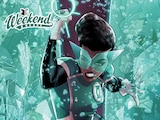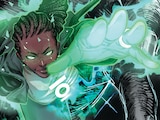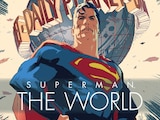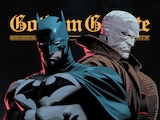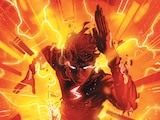The 2018 Aquaman movie and it’s recently released sequel, both directed by James Wan, are victories for superhero fans in multiple senses of the word. The films pull from various corners of Aquaman’s storied publication history, featuring deep cuts like an espionage-engaging octopus and an ancient villain pulled from a cult-favorite Aquaman prequel comic. Both movies lean unapologetically into the outlandish aspects of Aquaman comics, blessing our eyes with a comic-accurate Black Manta suit and Arthur’s loyal steed, Storm. To top it off, the first film also grossed over a billion dollars at the box office—not bad for a guy who was once a walking punchline on Super Friends.
But more than that, the Aquaman films give Arthur Curry a deeper cultural identity, with Jason Momoa playing a half-Māori version of the character. The Māori people are the indigenous people of Aotearoa/New Zealand. In the movies, iconic Māori actor Temuera Morrison plays Arthur Curry’s human father. Grounding Aquaman’s human identity in Māori culture brings the character a new level of significance. By equating his human identity with his Māori heritage, the Aquaman movies express one of the literal meanings of the word “Māori” in the Māori language: normal, or human being.

Beyond casting Aquaman and his family with actors of Polynesian descent, the Aquaman films, particularly the first one, incorporate several different elements of Māori culture in Arthur’s home life and activities as a superhero. Firstly, his father’s home has a tekoteko on the mantle. A tekoteko is a carved human figure in Māori culture. It represents one’s ancestors, and is an important way for their descendants to honor them. This supplements the franchise’s themes of family. In Māori culture, ancestors, or tūpuna, can be called on for strength. And while Arthur’s quest to reclaim the throne of Atlantis in Aquaman doesn’t directly spin out of his Māori heritage, his embrace of his Atlantean roots parallels the importance of ancestral knowledge in Māori culture.
Tom and Arthur Curry’s Māori heritage is not just relegated to the movies’ production design, either. In one Aquaman scene, when Arthur reunites with Tom at his lighthouse in Maine, the two perform a hongi. A hongi is a traditional greeting in Māori culture, where two people touch their noses and foreheads together. This greeting is part of a larger emphasis on welcoming and being welcomed into someone’s home in Māori culture. The warmth of Arthur and Tom’s familial relationship, represented in the hongi, can be contrasted with the violent way that Atlantis’s warriors crash into Tom’s house and fight Atlanna during a flashback in the beginning of the film.
Aquaman’s inclusion of a hongi provides another dimension to Arthur’s estrangement from Atlantis. Not only is he an outsider to Atlantean culture because of his human father, he’s also Māori. He’s coming from a human culture where welcoming outsiders is an important act, represented in things such as a powhiri welcoming ceremony. Arthur’s existence forces Atlantis to reckon with its hostility towards outsiders. Reframing Aquaman as a Māori superhero enhances the existing themes of Arthur Curry’s story.

Aquaman’s design in the movies as well as the way that he performs superheroic acts is also rooted in Māori culture. To start, he wears a pounamu jade around his neck. Pounamu is a type of green stone found in New Zealand that has long been used by Māori people to make fishing hooks, weapons and jewelry. Aquaman’s pounamu is in the shape of a toki, or a type of chisel. This symbolizes strength, which is fitting for a guy who can fight off pirates like they were kittens.
Aquaman also incorporates Māori martial arts and phrases into his fight scenes. When Aquaman fights Black Manta and his father, he rips off a rod from the wall of the submarine and holds it to the side of his body. Before launching the rod at Black Manta’s father, he says, “Anā tō kai,” which translates to “serves you right.” Aquaman’s stance and manner of wielding the rod is in the style of mau rākau, or Māori martial arts.
There are some interesting parallels between mau rākau and Aquaman’s method of combat. It’s worth noting that Aquaman wields his Atlantean trident in a similar manner to mau rākau. Some traditional weapons used in mau rākau include staffs like the taiaha. In comparison to other Atlanteans like his brother Orm, Arthur wields his trident in a much different style, very similarly to a taiaha in mau rākau. Even when participating in Atlantean battles, Aquaman’s fighting style is representative of his Māori roots.

Additionally, the movies place a great importance on tridents themselves. In Aquaman, Orm recognizes that Arthur is using their mother’s trident. Later, Arthur must travel to find the film’s central mythological object—the trident of King Atlan. In Aquaman and the Lost Kingdom, it’s the Black Trident that possesses Black Manta and tempts Orm. In Māori culture, weapons used in combat are considered to be taonga, or treasures, often passed down from generation to generation. This parallels the role that Atlanna’s trident plays in Arthur’s development as a warrior, as well as the significance that King Atlan’s trident has for Atlanteans and the Black Trident to Kordax. Of course, Aquaman’s journey to find King Atlan’s trident is also reminiscent of the myth of King Arthur and his sword, Excalibur, but that’s precisely what makes these such culturally-rich films. There are multiple cultural references taking place at once, and that’s fun!
Aquaman is undeniably an iconic character and imbuing him with a Māori background enhances this further. As we can see, there are elements of the Aquaman mythos that are similar to Māori culture. By putting these two together, the Aquaman franchise has unlocked a fantastic new dimension for understanding Arthur Curry.
Aquaman and the Lost Kingdom, directed by James Wan and featuring Jason Momoa as Aquaman, is now in theaters. For news, trailers and other features on the King of Atlantis, visit our official Aquaman hub page.
Jules Chin Greene writes about comics for DC.com, and his work can also be found at Nerdist, Popverse and Multiverse of Color. You can follow him on Twitter and Bluesky at @JulesChinGreene.


